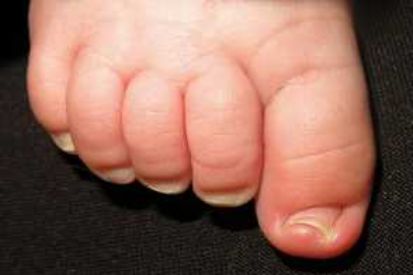Ingrown Toenails
Ingrown nails are distinguished by pain along the side or sides of the affected nail. This pain increases with the continued wearing of ill-fitting shoes. Often, the pain is so intense that even the slightest pressure can cause extreme discomfort.
When infections signs occur, it's time to consult board-certified dermatologist, Andrew Quillin.
Examples of Ingrown toenail




Symptoms of Ingrown Toenails?
- Infection signs such as redness, swelling, and the discharge of pus.
- Pain along the side or sides of the affected nail.
Causes of Ingrown Toenails
- Improper footwear, specifically, cramped shoes with insufficient room in the toes for proper nail growth.
- Poor nail cutting skills or trauma to the toe which injures the flesh and causes irregular nail growth.
How to Prevent Ingrown Toenails
- Proper Shoes: Wear well-fitting shoes with enough room for toes to prevent constriction.
- Nail Maintenance: Trim toenails straight across and avoid rounding the edges to discourage ingrowth. Be cautious while cutting nails, avoiding overly short trimming.
- Good Hygiene: Keep feet clean and dry, practicing good hygiene.
- Fabric Choice: Choose breathable socks and shoes to promote a healthy foot environment.
- Seek Professional Care: If an ingrown toenail is suspected, visit one of our providers promptly to prevent complications.
Ingrown Toenail FAQs
Ingrown toenails can be treated by soaking the foot in warm water, gently lifting the edge of the nail, and applying antibiotic ointment. In severe cases, you may need to visit a dermatologist for surgical removal.
You should see a dermatologist if you have severe pain, signs of infection (such as pus or redness spreading), or if home treatments are not effective.
It is not recommended to cut out an ingrown toenail yourself, as this can lead to infection or make the problem worse. It's best to see a dermatology professional for proper treatment.
Yes, ingrown toenails can be prevented by wearing properly fitting shoes, trimming nails straight across, avoiding cutting nails too short, and practicing good foot hygiene.
How to Treat Ingrown Toenails
It is always best to follow up with a visit to one of our trusted providers to assess the nail. If necessary, your dermatologist will perform a complete removal of the affected nail.
Featured Products

DefenAge 360-Rejuvenation Nail Serum
The 360-Rejuvenation Nail Root Serum is the first-ever nail rejuvenation serum that utilizes Defensin-molecules to target the real source of healthy nails – the root! As we age, our nails become thinner, weaker, and more fragile or brittle. Life habits, including our diet, daily tasks, and hobbies, also affect our nails. The root of nail growth is located in the nail matrix, in the LGR6+ cells that produce our nails and are responsible for nail regeneration. .22 fl oz

Nutrafol Collagen Infusion
The Collagen Infusion supplement treats the body from the inside out, strengthening and supporting the hair, skin, and nails. It hydrates the skin, enhancing elasticity and reducing signs of skin aging. Its antioxidants and nourishing properties promote hair follicle and overall scalp health for more luxurious, richer hair.
